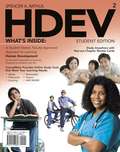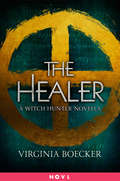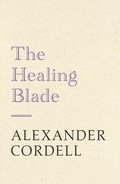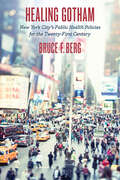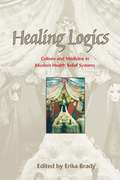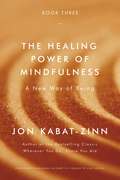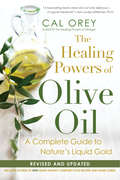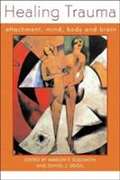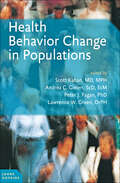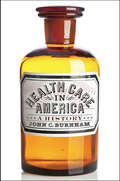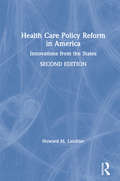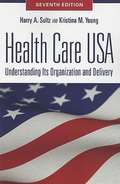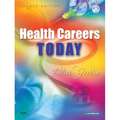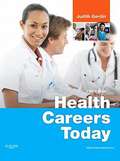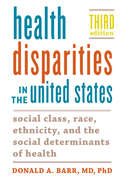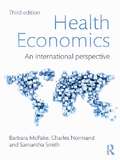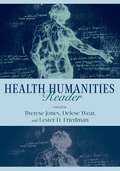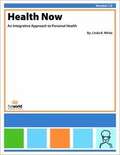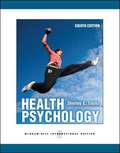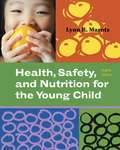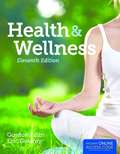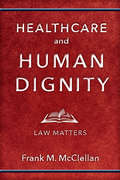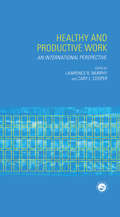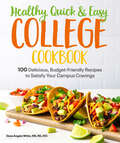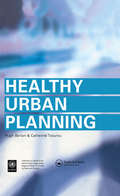- Table View
- List View
HDEV (2nd Edition)
by Spencer A. Rathus"HDEV, Second Edition" is a reader-friendly and concise text that traces human development from infancy through late adulthood without any delays or distractions.
The Healer: A Witch Hunter Novella (The Witch Hunter)
by Virginia BoeckerDon't miss this bewitching novella, set in the world of The Witch Hunter.John Raleigh, one of the youngest and most talented magical healers in all of Anglia, can relieve any ailment except, perhaps, his own broken heart. Since the deaths of his mother and sister who burned at the stake for witchcraft, John has spent his nights lost in nightmares and his days drowning in melancholy. That is until he's summoned to the home of Nicholas Perevil, the most powerful wizard in the kingdom, who suffers from a mysterious illness that has confounded every other healer. John immediately knows that this is no normal sickness. Nicholas, it seems, is falling apart because of a dangerous curse, and their only clue for a cure is a single name--Elizabeth Grey. Who is this girl and how has she become mixed up with such dark magic? John must put these questions aside when Elizabeth is brought to him from the palace's prison on the brink of death. It will take everything he has to save her, and to save Nicholas, but perhaps he'll manage to save his heart along the way. Word count: ~14,000 words
The Healing Blade: John Regan Trilogy Book Three
by Alexander CordellAn epic of the days when personal honour and patriotism were more important than any one man's life. John Regan has a secret mission crucial to the success of the infamous United Irishmen's Rebellion of 1798. A thrilling historical adventure for younger readers from the bestselling author of Rape of the Fair Country, first published in 1971 and now available as an eBook for the first time.
Healing Gotham: New York City’s Public Health Policies for the Twenty-First Century
by Bruce F. BergNew York City provides the ideal context for studying urban public health policy.Throughout its history, New York City has been challenged by a variety of public health crises. Since the nineteenth century—when it became one of the first American cities to develop a comprehensive public health infrastructure—New York has also stood at the forefront of formulating and implementing urban health policy. Healing Gotham examines in depth how the city has responded to five serious contemporary public health threats: childhood lead poisoning, childhood asthma, HIV/AIDS, obesity, and West Nile virus.Bruce F. Berg examines the rise and incidence of each condition in the city while explaining why the array of primary tools utilized by urban policy makers—including monitoring and surveillance, education, regulations, and the direct provision of services—have been successful in controlling public health problems. He also argues that forces such as race and ethnicity, New York City’s relationship to the state and federal government, the promotion of economic development, and the availability of knowledge related to preventing, treating, and managing illness all influence effective public health policy making.By contrasting these five particular cases, this exciting study allows scholars and students to compare public health policy through time and across type. It also helps policy makers understand how best to develop and implement effective public health strategies around the United States.
Healing Logics: Culture and Medicine in Modern Health Belief Systems
by Erika BradyScholars in folklore and anthropology are more directly involved in various aspects of medicine—such as medical education, clinical pastoral care, and negotiation of transcultural issues—than ever before. Old models of investigation that artificially isolated "folk medicine," "complementary and alternative medicine," and "biomedicine" as mutually exclusive have proven too limited in exploring the real-life complexities of health belief systems as they observably exist and are applied by contemporary Americans. Recent research strongly suggests that individuals construct their health belief systmes from diverse sources of authority, including community and ethnic tradition, education, spiritual beliefs, personal experience, the influence of popular media, and perception of the goals and means of formal medicine. Healing Logics explores the diversity of these belief systems and how they interact—in competing, conflicting, and sometimes remarkably congruent ways. This book contains essays by leading scholars in the field and a comprehensive bibliography of folklore and medicine.
The Healing Power of Mindfulness: A New Way of Being
by Jon Kabat-ZinnDiscover how mindfulness can help you with healing.More than twenty years ago, Jon Kabat-Zinn showed us the value of cultivating greater awareness in everyday life with his now-classic introduction to mindfulness, Wherever You Go, There You Are. Now, in The Healing Power of Mindfulness, he shares a cornucopia of specific examples as to how the cultivation of mindfulness can reshape your relationship with your own body and mind--explaining what we're learning about neuroplasticity and the brain, how meditation can affect our biology and our health, and what mindfulness can teach us about coming to terms with all sorts of life challenges, including our own mortality, so we can make the most of the moments that we have. Originally published in 2005 as part of a larger book titled Coming to Our Senses, The Healing Power of Mindfulness features a new foreword by the author and timely updates throughout the text. If you are interested in learning more about how mindfulness as a way of being can help us to heal, physically and emotionally, look no further than this deeply personal and also "deeply optimistic book, grounded in good science and filled with practical recommendations for moving in the right direction" (Andrew Weil, MD), from one of the pioneers of the worldwide mindfulness movement.
The Healing Powers of Olive Oil: A Complete Guide to Nature's Liquid Gold (Healing Powers)
by Cal Orey"A fascinating read--olive oil is not only delicious--it is good medicine!" --Ann Louise Gittleman, Ph.D."One of our most important foods. This book deserves to be in everybody's home library." --Elson M. Haas, M.D., author of Staying Healthy with Nutrition, 21st Century EditionDiscover Olive Oil's Extraordinary Powers!Revised and updated, this indispensible book reveals why chefs, doctors, and nutritionists all love extra virgin olive oil, a key ingredient in the Mediterranean Diet--and why other healthful oils from vegetables, fruits, and nuts are not far behind. You'll find easy recipes for satisfying foods like Pizza Baguettes with Garlic Oil, Fudgy Coconut Oil Brownies, Honey-Citrus-Olive Oil Fruit Kabobs, and Macadamia Nut Oil Cookies. Also included: home cures that beat colds and reduce pain, beauty and household secrets, and pet care tips that really work! Deliciously healing surprises. . ..The art of using olive oil for mind, body, and spirit goes back 6,000 years. Hippocrates, "the father of medicine," used olive oil in over 60 healing remedies. New research confirms that olive oil can help lower the risk of heart disease, cancer, and type 2 diabetes, and it can stall age-related diseases. Combining olive oil with other oils (like coconut and macadamia nut oils), can help combat fatigue, infections, and insomnia, and help you fight fat and shape up! Bring on the butter--especially the right kind and right amount. When paired with oils, this twentieth-century "forbidden" saturated fat is a new twenty-first-century health food. "Orey gives kudos to olive oil--and people of all ages will benefit from her words of wisdom." --Dr. Will Clower, CEO Mediterranean Wellness
Healing Trauma: Attachment, Mind, Body, and Brain
by Daniel J. Siegel Marion F. SolomonAs we move into the third millennium, the field of mental health is in an exciting position to bring together diverse ideas from a range of disciplines that illuminate our understanding of human experience: neurobiology, developmental psychology, traumatology, and systems theory. The contributors emphasize the ways in which the social environment, including relationships of childhood, adulthood, and the treatment milieu change aspects of the structure of the brain and ultimately alter the mind.
Health Behavior Change in Populations
by Scott Kahan, MD, MPH Andrea C. Gielen, ScD, ScM Peter J. Fagan Lawrence W. Green, DrPHFocuses on today’s major public health concerns to teach students the principles of population health behavior and behavior change.The single greatest way to improve health and quality of life is not by developing new medical approaches, but by addressing harmful personal behaviors. These behaviors—which include tobacco, alcohol, and drug use, diet, and physical activity—play a significant role in the risk for and development, treatment, and management of the most common causes of disease, disability, and death in the modern world. Health Behavior Change in Populations is designed to teach students and practitioners strategic principles for creating positive behavioral change on a population level. With an emphasis on the application of theory and research to practice, this textbook presents current and future public health professionals with a range of methods geared towards helping people make healthy choices, from informing the individual to modifying the surroundings and circumstances that drive decision-making. Written and edited by experts in the health professions, the book is arranged into three sections: State of the Field, State of the Science, and Cross-Cutting Issues. The chapters within these sections include learning objectives with boldfaced keywords and a glossary of terms. Each chapter addresses• The magnitude of the public health burden• Key determinants and conceptual framework for behaviors and behavior change, including individual, familial, interpersonal, community, sociocultural, structural, and political perspectives• Current evidence-based interventions and best practices• Roles for key stakeholders, including health plans, employers/workplace, health departments/agencies, sectors such as recreational and agricultural, policymakers, community groups/advocates, clinics/clinicians, researchers, and funding institutions • Considerations for implementation, evaluation, and translation
Health Care in America: A History
by John C. BurnhamA comprehensive history of sickness, health, and medicine in America from Colonial times to the present.In Health Care in America, historian John C. Burnham describes changes over four centuries of medicine and public health in America. Beginning with seventeenth-century concerns over personal and neighborhood illnesses, Burnham concludes with the arrival of a new epoch in American medicine and health care at the turn of the twenty-first century.From the 1600s through the 1990s, Americans turned to a variety of healers, practices, and institutions in their efforts to prevent and survive epidemics of smallpox, yellow fever, cholera, influenza, polio, and AIDS. Health care workers in all periods attended births and deaths and cared for people who had injuries, disabilities, and chronic diseases.Drawing on primary sources, classic scholarship, and a vast body of recent literature in the history of medicine and public health, Burnham finds that traditional healing, care, and medicine dominated the United States until the late nineteenth century, when antiseptic/aseptic surgery and germ theory initiated an intellectual, social, and technical transformation. He divides the age of modern medicine into several eras: physiological medicine (1910s–1930s), antibiotics (1930s–1950s), technology (1950s–1960s), environmental medicine (1970s–1980s), and, beginning around 1990, genetic medicine. The cumulating developments in each era led to today's radically altered doctor-patient relationship and the insistent questions that swirl around the financial cost of health care.Burnham's sweeping narrative makes sense of medical practice, medical research, and human frailties and foibles, opening the door to a new understanding of our current concerns.
Health Care Policy Reform in America: Innovations from the States
by Howard M. LeichterThis work tracks the role of the states in US health care policy reform. It reviews the challenges faced by the states in dealing with rising costs and looks at their policy competence and role in managed care, whilst focusing on the outcomes of policy reform in states such as Hawaii and Oregon.
Health Care USA
by Harry A. Sultz Kristina M. YoungHealth Care USA, Seventh Edition, Offers Students Of Health Administration, Medicine, Public Health, And Related Fields The Most Comprehensive Overview Of America's Health Care System Under A Single Cover. Combining Historical Perspective With Analysis Of Modern Trends, This Expanded Edition Charts The Evolution Of Modern American Health Care, Providing A Complete Examination Of Its Organization And Delivery While Offering Critical Insight Into The Issues That The U. S. Health System Faces Today. From A Physician-Dominated System To One Defined By Managed Care And Increasingly Sophisticated Technology, This Essential Text Explains The Transformation Underway And The Professional, Political, Social, And Economic Forces That Guide It Today And Will In The Future. Exhaustive In Breadth And Balanced In Perspective, Health Care USA, Seventh Edition, Provides Students With A Clearly Organized, Straightforward Illustration Of The Complex Structures, Relationships And Processes Of This Rapidly Growing, $2. 5 Trillion Industry. The Seventh Edition Has Been Thoroughly Revised To Reflect Recent Developments In This Dynamic Industry. The Latest Edition Features: - A Comprehensive Overview Of The Complex And Evolving U. S. Health Care System, Plus Revised Data, Material And Analysis Throughout. - The Latest Benchmark Developments In Health Care, Including The Response Of Public Health To Swine Flu And The Obama Administration's Health Care Reform. - A Look At The Recent Recession's Effects On Hospital Finances. - New Projections And Data Trends On The Country's Health Care Spending. - A Forward-Looking Perspective On The Future Of The U. S. Health Care System.
Health Careers Today
by Judith GerdinCovering more than 45 health careers, this book offers a practical overview to help students make an informed decision in choosing a profession. Not only does it discuss the roles and responsibilities of various occupations, it provides a solid foundation in the skills needed for all health careers. Clear explanations of anatomy and physiology provide essential knowledge of health related to the human body, and show how this applies to different careers. Content in the book now adheres to and reflects National Health Care Skills Standards. A clear writing style makes it easy for students to explore health career options. Health career discussions include the requirements and roles and responsibilities of each. Full-color drawings and photographs illustrate concepts, techniques, and equipment. Summaries of essential points introduce new concepts and help with exam preparation. Anatomy and Physiology unit covers all of the body systems, and applies A&P to practice. Skill Activities provide the opportunity to obtain hands-on experience. Learning Objectives at the beginning of each chapter help readers focus on key information. Key Terms with definitions are listed at the beginning of each chapter. Core concepts are reinforced with more than 70 content boxes, skill boxes, review questions, and critical thinking questions. A comprehensive glossary includes all key terms and definitions for quick reference. The companion CD-ROM has been completely revised, now including over 20 all-new skills videos, animations, chapter-specific quizzes, and an audio glossary. NEW Culture and Health Care chapter provides information on cultural and religious diversity as required by the National Health Care Skills Standards (NHCSS), including strategies that various cultures use to solve health-related problems, clients and patients who use English as a second language, and the awareness of religious diversity as it relates to client care. NEW Standards and Accountabilities section appears at the end of appropriate chapters, with the specific number and name of each national standard covered, along with its page number, so that correlations can be found quickly and easily. Revised Interpersonal Dynamics and Communication chapter now includes information on team-building, goal-setting, evaluation, and traits of leaders and team members. NEW chapter summaries review and identify vital content covered in each chapter. Seven new skills have been added, offering additional hands-on experience.
Health Careers Today
by Judith GerdinDescribing more than 45 health careers, Health Careers Today, 5th Edition offers a practical overview to help you make an informed decision in choosing a profession. Not only does it discuss the roles and responsibilities of various occupations, it provides a solid foundation in the skills needed for all health careers. Clear explanations of anatomy and physiology provide essential knowledge of health related to the human body, and show how this applies to different careers. A companion Evolve website includes skills videos, animations, quizzes, and flashcards. Written by experienced educator Judith Gerdin, this book reflects National Health Care Skills Standards. A clear, easy-to-read approach makes it easy to explore health career options. Over 45 health careers are discussed, including the requirements and roles and responsibilities of each. Full-color drawings and photographs illustrate concepts, techniques, and equipment. The National Health Care Skills Standards are incorporated, and the book's organization closely follows the standards. An Anatomy and Physiology unit covers all of the body systems, and applies A&P to various career settings. Skill Activities provide the opportunity to obtain hands-on experience. Learning Objectives at the beginning of each chapter focus on key information. Key Terms with definitions are listed at the beginning of each chapter. Core concepts are reinforced with more than 70 content boxes, skill boxes, review questions, and critical thinking questions. National Standard sections summarize the specific number and name of each national standard covered in that chapter, along with page references. Chapter summaries make it easy to review and identify key content. A comprehensive glossary includes all key terms and definitions for quick reference. Student resources on a companion Evolve website include fill-in-the-blank and drag-and-drop quizzes, flashcards, anatomy and physiology animations, skill videos, an audio glossary, and web links. A workbook corresponds to the chapters in the textbook, and features learning activities such as vocabulary practice exercises, medical abbreviation practice exercises, coloring/labeling activities, concept application exercises, laboratory exercises, critical thinking exercises, and Internet activities. Sold separately. Updated and expanded content covers the electronic medical record, HIPAA, examples of career ladders in various health professions, superbugs and MRSA, cultural diversity, autism, BMI and its relationship to obesity, infection control, basic methods of cleaning and sterilizing instruments, HOSA guidelines, and all NHCSS (National Health Care Skills Standards) required information. Bios and photographs feature working professionals in many health careers, adding personal stories that you can relate to. Brain bytes reinforce concepts and keep you engaged in the material. New photographs show workers in various health care settings. References to websites connect you to online resources and research. Full-page forms are located in the appendix, with printable versions available on the companion Evolve website for use in assignments.
Health Disparities in the United States: Social Class, Race, Ethnicity, and the Social Determinants of Health
by Donald A. BarrChallenging students to think critically about the complex web of social forces that leads to health disparities in the United States.The health care system in the United States has been called the best in the world. Yet wide disparities persist between social groups, and many Americans suffer from poorer health than people in other developed countries. In this revised edition of Health Disparities in the United States, Donald A. Barr provides extensive new data about the ways low socioeconomic status, race, and ethnicity interact to create and perpetuate these health disparities. Examining the significance of this gulf for the medical community and society at large, Barr offers potential policy- and physician-based solutions for reducing health inequity in the long term.This thoroughly updated edition focuses on a new challenge the United States last experienced more than half a century ago: successive years of declining life expectancy. Barr addresses the causes of this decline, including what are commonly referred to as "deaths of despair"—from opiate overdose or suicide. Exploring the growing role geography plays in health disparities, Barr asks why people living in rural areas suffer the greatest increases in these deaths. He also analyzes recent changes under the Affordable Care Act and considers the literature on how race and ethnicity affect the way health care providers evaluate and treat patients.As both a physician and a sociologist, Barr is uniquely positioned to offer rigorous medical explanations alongside sociological analysis. An essential text for courses in public health, health policy, and sociology, this compelling book is a vital teaching tool and a comprehensive reference for social science and medical professionals.
Health Economics: An International Perspective
by Barbara Mcpake Samantha Smith Charles NormandThis third edition of Barbara McPake and Charles Normand's textbook confirms it as providing the only properly international treatment of health economics on the market. A key tenet of the book is its analysis of comparative health systems across borders, and the text has been updated and revised to take account of changes in a host of countries. Barack Obama's reforms in the United States are considered alongside the provision of healthcare in China, providing a unique overview of these different approaches. The introduction of performance related payment in various forms is appraised, with the experience of developing countries such as Cambodia, Rwanda and Uganda important in this regard. An overview of the range of mathematical techniques available to perform economic evaluation in healthcare is also introduced, although the text avoids becoming too technical. In all, the text builds on the success of the first edition and provides the perfect introduction to the fast changing world of health economics.
Health Humanities Reader
by Professor Therese Jones Professor Delese Wear Professor Lester D. Friedman Mark Vonnegut Arthur W. Frank David H. Flood Rhonda L. Soricelli Lisa Keränen Michael Sappol Shelley Wall Martha Stoddard Holmes Joseph N. Straus Martin F. Norden Professor Lisa I. Iezzoni Felicia Cohn Martha Montello John Lantos Amy Haddad Rebecca Garden Mark Clark Howard Brody Rebecca Hester Jack Coulehan Rosemarie Tong Sander L. Gilman Professor Bernice Hausman Gretchen A. Case Allen Peterkin Alice Dreger Marjorie Levine-Clark Susan M. Squier Rafael Campo Sayantani DasGupta Jonathan M. Metzl Daniel Goldberg Maren Grainger-Monsen Thomas R. Cole Benjamin Saxton E. Ann Kaplan Jerald Winakur Bradley Lewis Anne Hudson Jones Michael Rowe Ian Williams Tod Chambers Raymond C. Barfield Lucy Selman Jeffrey P. Bishop Audrey Shafer Catherine Belling Paul Root Wolpe Professor Allison B. Kavey Jeff Nisker Julie M. Aultman Michael Blackie Erin Gentry Lamb Alan Bleakley Jay BaruchOver the past forty years, the health humanities, previously called the medical humanities, has emerged as one of the most exciting fields for interdisciplinary scholarship, advancing humanistic inquiry into bioethics, human rights, health care, and the uses of technology. It has also helped inspire medical practitioners to engage in deeper reflection about the human elements of their practice.In Health Humanities Reader, editors Therese Jones, Delese Wear, and Lester D. Friedman have assembled fifty-four leading scholars, educators, artists, and clinicians to survey the rich body of work that has already emerged from the field—and to imagine fresh approaches to the health humanities in these original essays. The collection’s contributors reflect the extraordinary diversity of the field, including scholars from the disciplines of disability studies, history, literature, nursing, religion, narrative medicine, philosophy, bioethics, medicine, and the social sciences. With warmth and humor, critical acumen and ethical insight, Health Humanities Reader truly humanizes the field of medicine. Its accessible language and broad scope offers something for everyone from the experienced medical professional to a reader interested in health and illness.
Health Now
by Linda B. WhiteIntended for the college-level Personal Health course. Health Now: An Integrative Approach to Personal Health by Linda B. White, M.D. covers the concepts you expect but adds a few important innovations that will capture students' attention and help you deliver the most current content. White pays far more than lip service to the rise of complementary and alternative medicine (CAM).
Health Psychology, Eighth Edition
by Shelley E. TaylorThe book highlights health issues that face the college student and his or her family through both accessible research examples and profiles of interventions such as coping with stress, maintaining physical health, and making decisions about alcohol and smoking. This edition contains clear descriptions of current research into the prevention, treatment, and causes (social, genetic, and biological) of specific health related disorders.
Health, Safety, and Nutrition for the Young Child
by Lynn R. MarotzHEALTH, SAFETY, AND NUTRITION FOR THE YOUNG CHILD, 8th Edition, covers the contemporary health, safety, and nutrition needs of infant through school-age children in one comprehensive volume, with extensive coverage of topics critical to the early identification of children's health conditions and the promotion of children's well-being. Concepts are backed by the latest research findings and linked to the key professional standards of the field. Collaboration with families, sensitivity to individual differences, and the critical importance of health, safety, and nutrition education continue to be stressed. Written in a clear, concise, and thought-provoking manner, this time-proven book is filled with easy-to-access checklists, guidelines, and lesson plans that no early childhood student or professional should be without!
Health & Wellness, Eleventh Edition
by Gordon Edlin Eric GolantyRevised and updated throughout with the latest data and statistics, the Eleventh Edition of Health & Wellness engages students with specific tips and guidelines to help them evaluate and improve their health habits. The text, along with the accompanying website, encourages students to learn the skills they need to enhance the quality and longevity of their life. Health and Wellness covers the many perspectives of personal health, including physical, emotional, mental, social, environmental, and spiritual perspectives, with a central theme of self-responsibility for one’s behavior.
Healthcare and Human Dignity: Law Matters (Critical Issues in Health and Medicine)
by Frank M. McClellanThe individual and structural biases that affect the American healthcare system have serious emotional and physical consequences that all too often go unseen. These biases are often rooted in power, class, racial, gender or sexual orientation prejudices, and as a result, the injured parties usually lack the resources needed to protect themselves. In Healthcare and Human Dignity, individual worth, equality, and autonomy emerge as the dominant values at stake in encounters with doctors, nurses, hospitals, and drug companies. Although the public is aware of legal battles over autonomy and dignity in the context of death, the everyday patient’s need for dignity has received scant attention. Thus, in Healthcare, law professor Frank McClellan’s collection of cases and individual experiences bring these stories to life and establish beyond doubt that human dignity is of utmost priority in the everyday process of healthcare decision making.
Healthy and Productive Work: An International Perspective
by Cary L. Cooper Lawrence R. MurphyThe Enterprise Culture of the 1980s helped transform economies of Western Europe, but left behind a legacy of stress, both for managers and shop floor workers. The cost to business is seen in absenteeism, reduced productivity, compensation claims, health insurance and direct medical costs, which in the US cost approximately $150 billion a year. Str
Healthy, Quick & Easy College Cookbook: 100 Simple, Budget-Friendly Recipes to Satisfy Your Campus Cravings
by Dana Angelo WhiteA cookbook for college students who want to eat well without breaking the bank, with 100 simple, nutritious, and delicious recipes.You don't need to survive on fast food for four years!Every busy college student knows how difficult it can be to eat healthy and also do it on a tight budget, but eating healthy doesn't need to be hard! Healthy, Quick & Easy College Cookbook has everything you need to make simple, delicious, nutritious recipes that you'll love, and you won't have to break your budget to do it. You'll learn how to make breakfasts that will fuel your day, lunches that are simple but satisfying, and main dishes that will impress anyone - including your parents. You'll also learn how to make healthier snacks that aren't loaded with salt and sugar, sweet treats that are better than anything from a bag, and late night treats that you actually won't regret eating the next day. Here's what you'll find inside:100 simple and healthy recipes that any student can make, with basic ingredients and simple instructions that even the most inexperienced cook can followHelpful guidance for stocking a campus kitchen with the right tools and the essential basic ingredientsSimple but helpful tips for successful cooking, getting the most out of ingredients, stretching a food budget, and storing food safely Meal prep basics that will help students take full advantage of the time they have and also help them stretch their ingredients
Healthy Urban Planning
by Hugh Barton Catherine TsourouHealthy Urban Planning aims to refocus urban planners on the implications of their work for human health and well-being. If many of the problems faced in cities are to be resolved, improving health will be the fundamental goal of urban planners. Poor housing, poverty, stress, pollution, and lack of access to jobs, goods and services all impact upon health. This book provides practical advice on ways to integrate health and urban planning and will be essential reading for urban planners, developers, urban designers, transport planners, and those working in the fields of regeneration and renewal. It will also be of interest to those with an interest in sustainable development.
